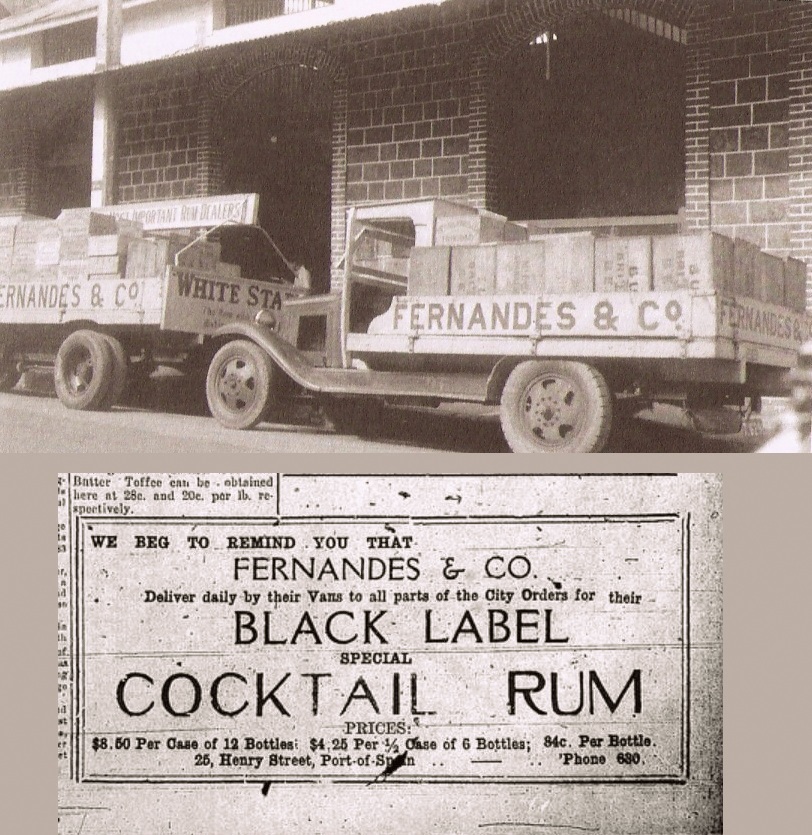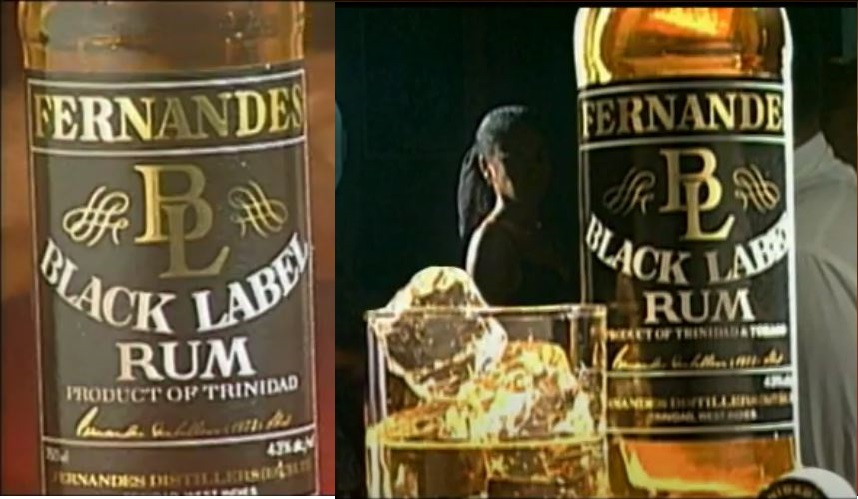There are rums that deserve some recognition for their role in rum history or importance to rum cocktail culture. Rum writer Lone Caner has what he refers to as the Key Rums of the World; rums that are referenced often, reasonably priced, and useful in understanding rum history These include intense white rums like Wray and Nephew Overproof and River Antoine, the Foursquare Exceptional Cask Series, and many others. Fernandes Black Label Rum may not meet the criteria for being a key rum of the world, simply because it’s barely known beyond Trinidad and Tobago and hardly even talked about locally. Despite this, it is certainly noteworthy and deserving of discussion for its role in Trinidad rum history, and potential for it to be an iconic brand again.
The Fernandes Rum Company was founded by Manoel Fernandes, an immigrant from Madeira who came to the Caribbean during the late 1800s. By the time that he set up his shop on Henry Street, Port of Spain, the Portuguese-Creole community was already well-entrenched in the business of blending rum and operating bars. The first immigrants from Madeira had come to the island several decades earlier, fleeing both religious persecution, and crisis in the wine industry caused by a pest that kills grape vines. They were originally Indentured laborers, but over time they shifted towards commercial activity as shopkeepers. Several factors aligned to ensure their success as rum blenders; they had experience as wine blenders, connections in the old country to source barrels for aging, and the opportunity to learn the different languages that their customers spoke. This would have included Bhojpuri and French Creole, and learning these alongside English might have given them an advantage over more established British merchants. They were also a tight knit community that could buy rum in bulk from the sugar estates and assist each other in different ways.
By the time that Fernandes established his business in 1890, he had likely apprenticed under a more established rum blender for a few years. Details on the first Fernandes rums are currently unknown, but they may have been similar to the rum sold by other Portuguese rum blenders on Henry Street. The nearby Black Cat Bar offered a fifteen year old Caroni Rum, and the brother-in-law of Fernandes operated a bar on his behalf on the corner of Henry and Queen Street where he also sold fifteen year old rum. Both these bars also sold cocktail bitters, and what they referred to as “Old Rum” with no age statement.
By 1920, Manoel’s son, Jose Gregario Fernandes had expanded the business so that there were now retail outlets in San Fernando and Diego Martin. Around this time, Fernandes Black Label Cocktail Rum was first introduced. Johnnie Walker had first used the term Black Label for one of their whiskies in 1906. By the time that Fernandes used the term, it would have been an indicator of quality and consistency in the world of alcoholic beverages. Using the name Black Label allowed them to source a broad range of rums from different estates and of different ages, and then blend it into a consistent product. Older rums would bring refinement while younger rums could lend intensity. The components could be balanced accordingly, and a skilled blender could ensure that Fernandes Black Label was more complex than each of the individual rums used.

The rum was sold to bars all across the country, and a fleet of trucks delivered rum daily within Port of Spain. It is fair to say that the Fernandes empire was built on Black Label Rum. Steady sales of this rum helped to fund two of Fernandes’ most important acquisitions in the 1930s; the purchase of the Forres Park Estate, and the purchase of the stock used for blending the initial batch of 1919 Rum. Following the second of these acquisitions, Fernandes began increasingly promoting Fernandes 1919 and its successor, Fernandes VAT 19 as their flagship rum. Despite this, Black Label Rum remained popular. The lack of advertising is likely because it simply did not need to be advertised. The following decades saw several rums from Angostura and Caroni like Old Oak and Felicite Gold respectively positioned against Black Label Rum. The fact that Black Label Rum has outlasted them all is testament to its longstanding popularity.
By the 1980s, Fernandes Black Label Rum was considered a classic, and advertising during this era attempted to link the rum with art also considered to be classic. A 1987 advertisement opened with the words; “Classics are forever, transcending the boundaries of fad or fashion, the appeal is timeless; Like Fernandes Black Label Rum”. It showed a montage of classic art, and saw a glass of rum placed on a table next to a V.S. Naipaul novel before ending with the words; “truly a Trinidad and Tobago classic.”
Another advertisement from 1984 referenced the movie Carmen Jones, which at that time was seen as both a classic film and a nickname for Black Label Rum. It declared that; “A classic is forever… As exciting now as it was then, as it will be tomorrow. Fernandes Black Label, the classic rum.” and similarly ended with the words; “A Trinidad and Tobago Classic”.
Fifteen years later however, the brand had fallen out of fashion. Clear spirits like vodka, white rum, and gin were trending globally. Both a cause and effect of this phenomenon, was the screen time given to cocktails that call for clear spirits. Sex and the City is constantly credited with creating the Cosmopolitan craze. In his book And a Bottle of Rum, writer Wayne Curtis says that the 2002 James Bond movie Die Another Day helped make mojitos popular again. In Trinidad and Tobago, the clear spirit trend was reflected in a marked increase in white rum sales. Caroni’s White Magic Rum is often cited as the brand that started the rise in the status of white rum locally, but the brand that benefited the most from this trend was Old Oak. Not the original gold version that had been sold since the 1950s, but rather a version that was charcoal filtered to clarity and sold as Old Oak White Rum. Drinkers would request this by asking for White Oak, leading to an eventual name change and discontinuation of the gold version.
Advertisements from the early two thousands for Fernandes Black Label reference the rise of white rum, and in the face of this new trend, they reinforce that it was masculine and avant garde to be drinking Black Label Rum in this era. The use of well-established watering holes with loyal followings helped to establish authority, and reinforce the status of Black Label as a classic icon.
The Pelican Pub at the Pelican Inn was a popular lounge and liming spot open since the early 1960s. The accounts from people reminiscing about their time spent at the Pelican spans decades. Some remember playing darts on a Friday after work, while others talk about enjoying cold beer after a rugby game. In the advertisement, two friends go to the bar to order some rum. The bartender asks; “red of white?” referring to the color of the rum being requested, to which the friend who placed the order confidently responds; “Black. Fernandes Black.”
Smokey and Bunty was similarly started in the 1960s, but they moved to their iconic Saint James location in the late 1980s. Saint James at that time was regarded as the nightlife and street-food capital of the country, and Smokey and Bunty might have been the social hub of that suburb. The wording of this advertisement is the same as the one set at Pelican Inn, but it closes with Ricardo “Smokey” Mckenzie, co-owner of Smokey and Bunty saying; “for years now, everybody drinking white rum, but how everybody has changed to black. Fernandes Black Label Rum.”
By the time of those advertisements, both institutions were regarded as places that brought together different generations and social classes for the type of conversations that only happen in a Caribbean rum shop. Unfortunately, neither place from those advertisements still exists. The Pelican Inn was closed in 2005, and Smokey and Bunty was destroyed by a fire in 2015. Fernandes Black Label Rum has outlived almost all of the bars where it was made popular, and it has outlasted every single rum designed to compete with it.
Currently, Fernandes Black Label is unpopular with younger drinkers, and older drinkers who might have once reached for a bottle would likely now request a more premium rum. The classic status however, is still there. And like the decades old advertisement said; “Classics are forever, transcending the boundaries of fad or fashion.” Despite being a shell of its former self, Fernandes Black Label has incredible brand equity and potential for being further developed by Angostura in the future.



